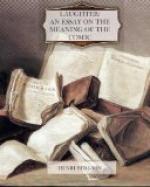Many a comic scene may indeed be referred to this simple type. For instance, in the scene of the Mariage force between Sganarelle and Pancrace, the entire vis comica lies in the conflict set up between the idea of Sganarelle, who wishes to make the philosopher listen to him, and the obstinacy of the philosopher, a regular talking-machine working automatically. As the scene progresses, the image of the Jack-in-the-box becomes more apparent, so that at last the characters themselves adopt its movements,—Sganarelle pushing Pancrace, each time he shows himself, back into the wings, Pancrace returning to the stage after each repulse to continue his patter. And when Sganarelle finally drives Pancrace back and shuts him up inside the house—inside the box, one is tempted to say—a window suddenly flies open, and the head of the philosopher again appears as though it had burst open the lid of a box.
The same by-play occurs in the Malade Imaginaire. Through the mouth of Monsieur Purgon the outraged medical profession pours out its vials of wrath upon Argan, threatening him with every disease that flesh is heir to. And every time Argan rises from his seat, as though to silence Purgon, the latter disappears for a moment, being, as it were, thrust back into the wings; then, as though Impelled by a spring, he rebounds on to the stage with a fresh curse on his lips. The self-same exclamation: “Monsieur Purgon!” recurs at regular beats, and, as it were, marks the tempo of this little scene.
Let us scrutinise more closely the image of the spring which is bent, released, and bent again. Let us disentangle its central element, and we shall hit upon one of the usual processes of classic comedy,—repetition.
Why is it there is something comic in the repetition of a word on the stage? No theory of the ludicrous seems to offer a satisfactory answer to this very simple question. Nor can an answer be found so long as we look for the explanation of an amusing word or phrase in the phrase or word itself, apart from all it suggests to us. Nowhere will the usual method prove to be so inadequate as here. With the exception, however, of a few special instances to which we shall recur later, the repetition of a word is never laughable in itself. It makes us laugh only because it symbolises a special play of moral elements, this play itself being the symbol of an altogether material diversion. It is the diversion of the cat with the mouse, the diversion of the child pushing back the Jack-in-the-box, time after time, to the bottom of his box,—but in a refined and spiritualised form, transferred to the realm of feelings and ideas. Let us then state the law which, we think, defines the main comic varieties of word-repetition on the stage: In A comic repetition of words we generally find two terms: A repressed feeling which goes off like A spring, and an idea that delights in repressing the feeling anew.




